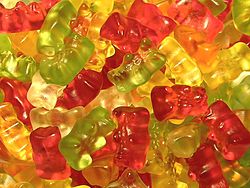Gummy bear

Haribo gummy bears, the first gummy bears ever made
|
|
| Type | Gummi candy |
|---|---|
| Place of origin | Germany |
| Creator | Hans Riegel Sr. |
| Main ingredients | Gelatin, sugar, glucose syrup, starch, flavoring, food coloring, citric acid |
| |
|
| Nutritional value per 100 g (3.5 oz) | |
|---|---|
| Energy | 1,459 kJ (349 kcal) |
|
77 g
|
|
| Sugars | 46 g |
|
0 g
|
|
|
6.9 g
|
|
|
|
| Percentages are roughly approximated using US recommendations for adults. | |
A gummy bear (German: Gummibär) is a small, fruit gum candy, similar to a jelly baby in some English-speaking countries. The candy is roughly 2 cm (0.8 in) long and shaped in the form of a bear. The gummy bear is one of many gummies, popular gelatin-based candies sold in a variety of shapes and colors.
The gummy bear originated in Germany, where it is popular under the name ![]() Gummibär (gum or gummy bear) or in the endearing form
Gummibär (gum or gummy bear) or in the endearing form ![]() Gummibärchen ([little] gum or gummy bear), gum arabic was the original base ingredient used to produce the gummy bears, hence the name gum or gummy. Hans Riegel, Sr., a confectioner from Bonn, started the Haribo company in 1920. In 1922, inspired by the trained bears seen at street festivities and markets in Europe through to the 19th century, he invented the Dancing Bear (Tanzbär), a small, affordable, fruit-flavored gum candy treat for children and adults alike, which was much larger in form than its later successor, the Gold-Bear (Goldbär). Even during Weimar Germany's hyperinflation period that wreaked havoc on the country, Haribo's fruit-gum Dancing Bear treats remained affordably priced for a mere 1 Pfennig, in pairs, at kiosks. The success of the Dancing Bear's successor would later become Haribo's world-famous Gold-Bears candy product in 1967.
Gummibärchen ([little] gum or gummy bear), gum arabic was the original base ingredient used to produce the gummy bears, hence the name gum or gummy. Hans Riegel, Sr., a confectioner from Bonn, started the Haribo company in 1920. In 1922, inspired by the trained bears seen at street festivities and markets in Europe through to the 19th century, he invented the Dancing Bear (Tanzbär), a small, affordable, fruit-flavored gum candy treat for children and adults alike, which was much larger in form than its later successor, the Gold-Bear (Goldbär). Even during Weimar Germany's hyperinflation period that wreaked havoc on the country, Haribo's fruit-gum Dancing Bear treats remained affordably priced for a mere 1 Pfennig, in pairs, at kiosks. The success of the Dancing Bear's successor would later become Haribo's world-famous Gold-Bears candy product in 1967.
...
Wikipedia
